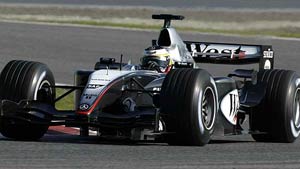You did mention that only the main plane and the first flap element are full length and the 2nd flap terminated at each side of the nose cone(its attached to the nose in the pic in your side).So which element actually producing lift(no..downforce actually ).
Only the middle of the outer sections (i.e. the two dipped sections) produce large amounts of downforce, the section under the nose produces very little being only two elements and higher from the ground.
Is it all three of them or only certain element?If all element is producing downforce..do all of them act as a single wing element with small spacing between them just to regenerate boundary layer or all three of them produce downforce in their own right?
Any multi element F1 wing acts as one elements the slot created between them reduces separation.
Since the 2nd flap is split under the nose,this means that under the nose,there are only 2 wing elements(main plane+1st flap) right?
Correct
Since there are in close proximity with the nose underside,there are only limited amount of space between flaps and nose. So the flow will expand just after the wing??
I don’t know what the flow does in this area, whether the duct (formed by the underside of the nose, drop plates and upper surface of the wing) is converging, parallel or divergent.
This question may sound silly to knowledgable person but I'm so curious to know the answer.If the flow expand after the wing and hence creating a low pressure area and this results in a pressure difference between upper section of nose and undernose in the area just behind the wing.Correct me if I'm wrong but this will results in further downforce
I have been told recently by Geoff Willis that no reasonable amount of negative pressure is created by under the nose of the chassis, and that flow in this region is more about directing it laterally to the sidepods and bargeboards.
I think.Better still can anyone draw the cutaway diagram of the side view of the MP4-19 nose...
I have a go at drawing it for you
The winglet at the sidepod is for vortex management or does it produce downforce as well????
The winglet is there to produce downforce, but it also shapes the flow around the rear of the car. If you could look at the pressure gradient across the wing from outer to inner, more DF is created at the outer end than the inner end. As the end plate and profile are tuned to create more DF at the outer end. If the inner side had the same layout a vortex would flow off the wing tip\endplate and head straight into the rear wing endplate, not very efficient. So the inner end of the wing is endplate’less and uses a flatter profile, this reduces the power of the vortex produced. This philosophy is applied the rear wings upper and lower elements, plus areas of the front wing.
Renault used it as a way to suck the air out from the chimney, hence the close proximity between the winglet and chimney on R23.
Correct
Still in the topic of vortex management,what I believe is the winglet purposes is something to do with flow management that will short after will hit the rear tyre.Maybe it is use to deflect the flow,or to create disturbance so that less drag is produced when it finally hit the rear tyre.
I understand more to direct the flow away from the rear wing.
Small outlet is created at end the ducktail at the rear of the gearbox.How the heat reach that area in the first place???
The gearbox and CV joints create the heat
Is is still part of the main bodywork?I thought the main bodywork is over at more or less in front of rear suspension apart from the top cover which extend further back to aid aerodynamic.
Yes, The duck tail is a derivative of Ferraris concept, unusually the McLaren version keeps the width broad and constant, rather than Ferraris bulged version
Scarbs….
[/quote]

